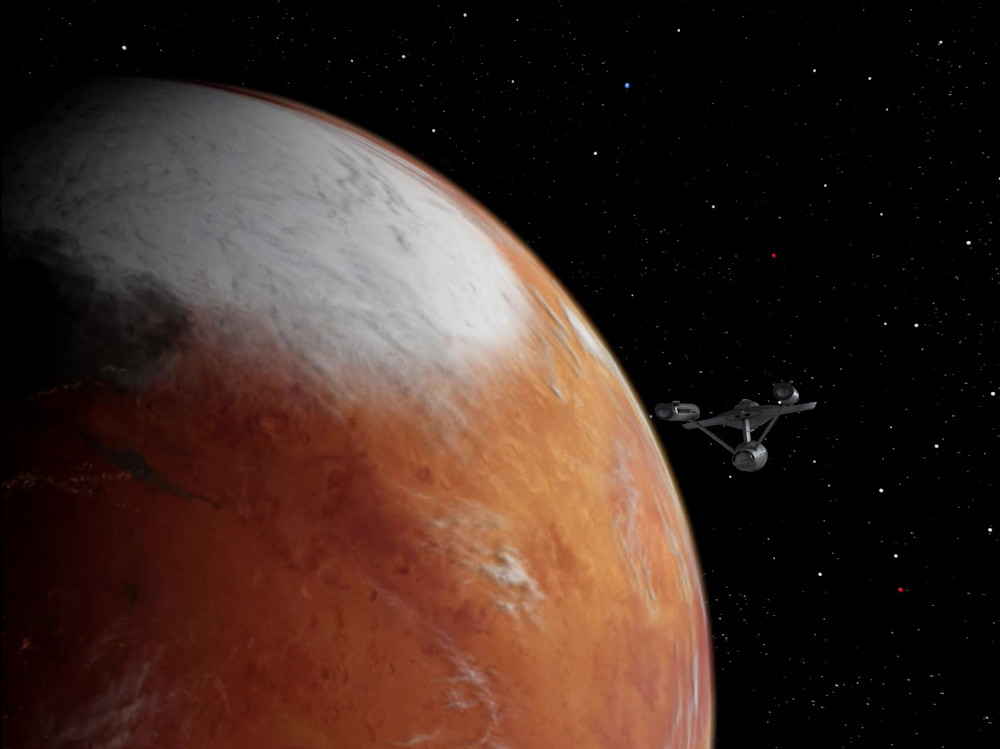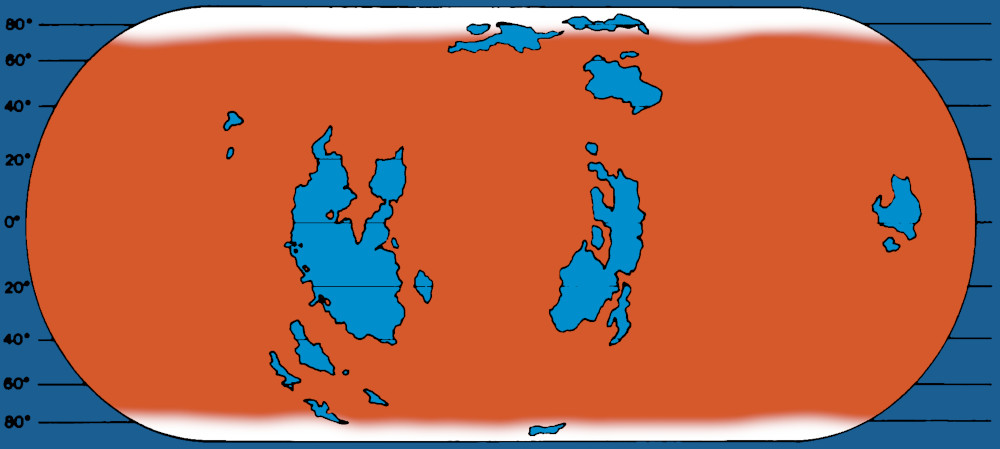Vulcan (FASA)
| Coordinates | 19.5, 60.0, -0.6[1] |
| Affiliation | Founding Member,[2] United Federation of Planets[3] |
| Class | M[4] |
| Gravity | 1.15g[5] |
| Diameter | 9,700km[5] |
| Equatorial Circumference | 14,500km[5][6] |
| Surface Area | 300,200,000km²[5] |
| Land Area | 225,150,000km²[5] |
| Hydrosphere | 14%[2]-25%[5] |
| Rotational Period | 27 hours[5] |
| Natural Satellites | None,[7] but shared its orbit with T'Khut[8][9] |
| Notable Species | Vulcans,[3] Sehlats,[4] Le-Matyas[8] |
| Notable Individuals | Surak,[10] Sarek,[4] Spock,[3] T'Lar[11] |
| Advertising |
The second planet[1] orbiting 40 Eridani A[12] and well known as a hot, desert world,[13] Vulcan nevertheless became the cradle for not just one,[3] but two major starfaring civilizations,[14] and was a founding member of the United Federation of Planets,[2] earning it a permanent seat on the Federation Council.[5]
Map of Vulcan (WoF) (Colorized; Original B&W Image)
Known as T'Khasi in the Vulcan language,[2] Vulcan was large, Class M world with a high surface gravity and temperature.[1] Though Vulcan had no moons,[15] it was part of a double planet grouping[9] that orbited 40 Eridani A; Vulcan's sister world was a Class H planet[2] called T'Khut,[16] which moved in a trojan relationship with Vulcan; both planets revolved around a common point in their shared orbit,[2] and their proximity caused T'Khut to dominate the Vulcan sky.[9]
Vulcan's native population boasted an advanced and highly intelligent civilization that predated humanity by several millennia. Vulcanoids were the second most common humanoid type in the Federation.[1] An ancient, peaceful race dedicated to logic, Vulcans have a strong sense of honor. Their dedication to logical thinking came as a result of near self-extermination in ancient times, when Vulcans were a hostile, warrior race whose lives were ruled by strong passions. Surak, the father of Vulcan philosophy, lived during the planet's last great wars.[10] After the world was left devastated, Surak met with emissaries from both sides of the war to establish a workable peace. The philosophy of logic eventually prevailed,a nd the planet was finally united.[2]
The Vulcan Science Academy, located in the city of ShiKahr, was one of the Federation's foremost institutes of higher learning.[2] By Reference Stardate 2/2306 (June 2223), the shipyard facilities at Vulcan produced an average of 20 warp shuttles and courier vessels, and 400 civilian and commercial vessels.[5] Several large port cities were located on the planet,[1] which was largely desert, with only 14% of the planet covered in water.[2] Vulcan boasted a population of 12.5 billion.[5]
Notes and References
- ↑ 1.0 1.1 1.2 1.3 1.4 Maynard, Jeff (Author). Star Trek Maps. Star Trek. Book. Bantam Books. August 1980.
- ↑ 2.0 2.1 2.2 2.3 2.4 2.5 2.6 2.7 2.8 Johnson, Shane. Star Trek: The Worlds of the Federation. Pocket Books, 1989.
- ↑ 3.0 3.1 3.2 3.3 Roddenberry, Gene (Executive Producer). "The Cage". Star Trek, season 0, episode 0 (Production number 01). Directed by Robert Butler. Written by Gene Roddenberry. Released 1986. Desilu Productions. 1965.
- ↑ 4.0 4.1 4.2 Roddenberry, Gene (Executive Producer). "Amok Time." Star Trek, Season 2, Episode 5. Directed by Joseph Pevney. Written by Theodore Sturgeon. Desilu Productions, 15 September 1967.
- ↑ 5.0 5.1 5.2 5.3 5.4 5.5 5.6 5.7 5.8 5.9 Menke, Bernard Edward and Rick David Stuart (Authors). The Federation. Star Trek: The Role Playing Game. Book 2011. Cover art by David R. Deitrick. Illustrations by Todd F. Marsh, John C. Tylk, Bob Eggleton, Daniel E. Carroll, and Jay Harris. FASA Corporation. 1986.
- ↑ Due to a typographical error, Vulcan's equatorial circumference was listed in the FASA supplement "The Federation" as 14.5 million kilometers, rather than the more appropriate 14,500 kilometers. This has been corrected for this entry.
- ↑ Roddenberry, Gene (Executive Producer). "The Enemy Within". Star Trek, season 1, episode 5 (Production number 05). Directed by Leo Penn. Written by Richard Matheson. Desilu Productions. 6 October 1966.
- ↑ 8.0 8.1 Scheimer, Lou & Norm Prescott (Producers). "Yesteryear". Star Trek: The Animated Series, season 1, episode 2 (Production number 03). Directed by Hal Sutherland. Written by D.C. Fontana. Filmation Associates. 15 September1973.
- ↑ 9.0 9.1 9.2 Roddenberry, Gene (Producer). Star Trek: The Motion Picture. Directed by Robert Wise. Story by Alan Dean Foster. Screenplay by Harold Livingston. Paramount Pictures. 7 December 1979.
- ↑ 10.0 10.1 Roddenberry, Gene (Executive Producer/Story and Teleplay) and Freiberger, Fred (Producer). "The Savage Curtain." Star Trek, Season 3, Episode 22. Directed by Herschel Daugherty. Teleplay by Arthur Heinemann. Paramount Pictures Corporation, 7 March 1969.
- ↑ Bennett, Harve (Producer). Star Trek III: The Search for Spock. Directed by Leonard Nimoy. Written by Harve Bennett. Paramount Pictures. 1 June 1984.
- ↑ Blish, James (Author). "Balance of Terror," Star Trek 1. Star Trek. Novelization . Adapted from "Balance of Terror," written by Paul Schneider. Ballantine Books. January 1967.
- ↑ Roddenberry, Gene (Executive Producer). "Journey to Babel." Star Trek, Season 2, Episode 15. Directed by Joseph Pevney. Written by D.C. Fontana. Desilu Productions, 17 November 1967.
- ↑ Roddenberry, Gene (Executive Producer). "Balance of Terror". Star Trek, season 1, episode 14 (Production number 09). Directed by Vincent McEveety. Written by Paul Schneider. Desilu Productions. 15 December 1966.
- ↑ Roddenberry, Gene (Executive Producer). "The Man Trap". Star Trek, season 1, episode 1 (Production number 06). Directed by Marc Daniels. Written by George Clayton Johnson. Desilu Productions. 8 September 1966.
- ↑ Roddenberry, Gene (Author). The Motion Picture. Star Trek. Novelization . Based on the screenplay by Harold Livingston and the story by Alan Dean Foster. Pocket Books. December 1979.









